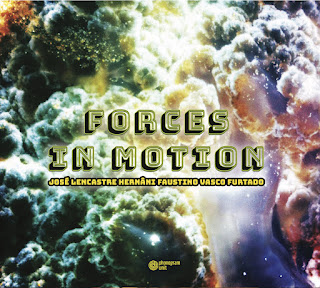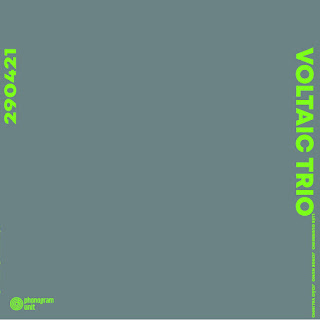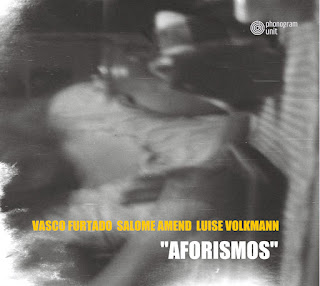By Paul Acquaro
It was a windy, warm mid-summer day when I sat down with saxophonist
José Lencastre in the concrete amphitheater of the Gulbenkian gardens in Lisbon. We talked about his music,
the flowering Lisbon scene, and his new baby, who was – at the time – about the same size of
his alto sax. Another topic we spent spent some time discussing was the upcoming recordings
from the musicians on the artist run Phonogram Unit label that he and several
musical partners had recently started.
José Lencastre in the concrete amphitheater of the Gulbenkian gardens in Lisbon. We talked about his music,
the flowering Lisbon scene, and his new baby, who was – at the time – about the same size of
his alto sax. Another topic we spent spent some time discussing was the upcoming recordings
from the musicians on the artist run Phonogram Unit label that he and several
musical partners had recently started.
José Lencastre / Hernâni Faustino / Vasco Furtado – Forces in Motion
(Phonogram Unit, 2021) ****½
The trio is Lencastre on alto saxophone,
Hernâni Faustino on electric bass (to date, I have known Faustino as an
double bassist with acoustic groups like the RED Trio), and drummer Vasco
Furtado. The first album, Vento, was reviewed by Stuart Broomer
here and he points out the ‘expressionist potential’ of the group. This
spirit continues to thrive on Forces in Motion, and perhaps is even
intensified through Faustino’s approach to the electric bass, in which the
round tones of the double bass are replaced with dry, staccato notes,
articulated in the mix and making the ground feel more ephemeral.
Hernâni Faustino on electric bass (to date, I have known Faustino as an
double bassist with acoustic groups like the RED Trio), and drummer Vasco
Furtado. The first album, Vento, was reviewed by Stuart Broomer
here and he points out the ‘expressionist potential’ of the group. This
spirit continues to thrive on Forces in Motion, and perhaps is even
intensified through Faustino’s approach to the electric bass, in which the
round tones of the double bass are replaced with dry, staccato notes,
articulated in the mix and making the ground feel more ephemeral.
The album opens quietly, with a splash of cymbals and then through an
extended welling of sound. The six minutes of ‘Dust’ rises and falls without
ever kicking up too much of a cloud, though it never settles either. It
leads to the 13 minute ‘Point of departure,’ which is a showcase of jittery
bass work and complimentary drumming. Lencastre probes the craggy
contours and in turn weaves an expressive melody. The tempo picks up as
the track progresses, Faustino plays a counter melody, while
Furtado responds with cracking stick-work. Lencastre is quick, he bobs
and weaves throughout the buzzing rhythm work. The pieces reaches a breaking
point and the three retreat. The third track, ‘Cascade’ picks up with the
exploratory sound of Faustino’s bass, augmented by electronics. The drums
and sax soon come in, Lencastre plays a searching melody and Furtado leans
into the tom-toms. The three explore a deliberate theme that eventually
builds to an intense apex. Lencastre, even when getting into the altissimo
register, doesn’t force his instrument, rather his sound is propelled by the
centrifugal forces of the rhythm. This both holds true too on the next long
piece “Lava Flow” that begins exploratory and builds to a peak with red hot
melodic rivulets streaming down its sides.
extended welling of sound. The six minutes of ‘Dust’ rises and falls without
ever kicking up too much of a cloud, though it never settles either. It
leads to the 13 minute ‘Point of departure,’ which is a showcase of jittery
bass work and complimentary drumming. Lencastre probes the craggy
contours and in turn weaves an expressive melody. The tempo picks up as
the track progresses, Faustino plays a counter melody, while
Furtado responds with cracking stick-work. Lencastre is quick, he bobs
and weaves throughout the buzzing rhythm work. The pieces reaches a breaking
point and the three retreat. The third track, ‘Cascade’ picks up with the
exploratory sound of Faustino’s bass, augmented by electronics. The drums
and sax soon come in, Lencastre plays a searching melody and Furtado leans
into the tom-toms. The three explore a deliberate theme that eventually
builds to an intense apex. Lencastre, even when getting into the altissimo
register, doesn’t force his instrument, rather his sound is propelled by the
centrifugal forces of the rhythm. This both holds true too on the next long
piece “Lava Flow” that begins exploratory and builds to a peak with red hot
melodic rivulets streaming down its sides.
The work of the trio on Forces in Motion is highly enjoyable.
Accessible and energetic, at times exploratory and others awash in pulse and
melody.
Accessible and energetic, at times exploratory and others awash in pulse and
melody.
Voltaic Trio – 290421 (Phonogram Unit, 2021) ****
During our conversation, Lencastre spoke about his group
Anthrophic Neglect, who were playing on the second weekend of Jazz em Agosto. For Lencastre,
playing at the festival was an honor, as it has been an important part of
his musical life. He cited some memorable shows that he had seen, then spoke
about the group, and in particular, guitarist Jorge Nuno.
Anthrophic Neglect, who were playing on the second weekend of Jazz em Agosto. For Lencastre,
playing at the festival was an honor, as it has been an important part of
his musical life. He cited some memorable shows that he had seen, then spoke
about the group, and in particular, guitarist Jorge Nuno.
Nuno is a part of the Phonogram Unit collective and his No Nation Trio
released
Habitation on the label in 2020. Whereas that album was a exploration of
acoustic textures and tones, this one is a face melting blast of electric
noise and a wealth of harsh, but nonetheless, fascinating rhythms and
textures. The group is Nuno on electric guitar (and an expansive pedal
board!), Luis Guerreiro on trumpet and electronics, and João Valinho on
drums.
released
Habitation on the label in 2020. Whereas that album was a exploration of
acoustic textures and tones, this one is a face melting blast of electric
noise and a wealth of harsh, but nonetheless, fascinating rhythms and
textures. The group is Nuno on electric guitar (and an expansive pedal
board!), Luis Guerreiro on trumpet and electronics, and João Valinho on
drums.
The album begins somewhat chaotically. A squelch of highly modified
electric guitar – in which no guitar really needs to be involved – appears
like a steamroller cutting through a haze. The trumpet then appears with a
flurry of sounds like a swarm circling menacingly.
After the initial sonic onslaught, the tension relaxes and each instrument
is given space to strategize for the next attack. Soon the tension
re-builds. The trumpet rings out, it’s natural sonic waves cut angular and
sharp with effects. The electronics bleep and sputter, creating a swirling
maelstrom and when the electronic fog lifts from to time to time augmenting
Valinho’s powerful drumming and Nunes’ biting guitar work. At times, one may
be reminded of Miles Davis during the thickest part of his music in the 70s,
though this trio goes deeper into the murky darkness.
electric guitar – in which no guitar really needs to be involved – appears
like a steamroller cutting through a haze. The trumpet then appears with a
flurry of sounds like a swarm circling menacingly.
After the initial sonic onslaught, the tension relaxes and each instrument
is given space to strategize for the next attack. Soon the tension
re-builds. The trumpet rings out, it’s natural sonic waves cut angular and
sharp with effects. The electronics bleep and sputter, creating a swirling
maelstrom and when the electronic fog lifts from to time to time augmenting
Valinho’s powerful drumming and Nunes’ biting guitar work. At times, one may
be reminded of Miles Davis during the thickest part of his music in the 70s,
though this trio goes deeper into the murky darkness.
Fierce and uncompromising, but also surprisingly textural and expressive,
the Voltaic Trio is a noisy post-punk, avant-garde experience that offers
tough listeners a rewarding challenge.
the Voltaic Trio is a noisy post-punk, avant-garde experience that offers
tough listeners a rewarding challenge.
Vasco Furtado – Salome Amend – Luise Volkmann – Aforismos (Phonogram Unit,
2021) ***½
I mentioned that it was windy out that evening in Lisbon, right? So windy, in
fact, that my recording of our conversation was rather inaudible, however,
that hardly matters, as for this last one we’re leaving the area and following
Vasco Furtado, the drummer on Forces in Motion, to his current
residence in western Germany. Here, he recorded with two German
experimental/jazz (this is really getting delightfully hard to categorize)
musicians: saxophonist Luise Volkmann and vibraphonist Salome Amend. The
result, Aforismos, is an experimental/jazz album that unfolds in 5
improvisations of varying duration.
fact, that my recording of our conversation was rather inaudible, however,
that hardly matters, as for this last one we’re leaving the area and following
Vasco Furtado, the drummer on Forces in Motion, to his current
residence in western Germany. Here, he recorded with two German
experimental/jazz (this is really getting delightfully hard to categorize)
musicians: saxophonist Luise Volkmann and vibraphonist Salome Amend. The
result, Aforismos, is an experimental/jazz album that unfolds in 5
improvisations of varying duration.
‘Folk Songs’ kicks off the album with a splash of cymbals, followed by
Volkmann’s searching saxophone and Amend’s vibraphone’s unresolved chords. Over
a patter of percussion, the exploratory grows more assured, though never
settled. Volkmann spends a good amount of the time quietly overblowing her
instrument, but playing in close connection with the percussive
instruments, interlocked in self-perpetuating patterns. ‘Mechananimus,’ the
second track, begins with Volkmann and Furtado instigating a moody atmosphere.
Acoustic noises drawn from extended techniques and overtones fill the space,
while ghostly notes from the vibraphone lurk in the background. As the track
progresses, the playing intensifies, especially the saxophone, leading to the
main track of the recording, ‘Intuitions,’ which unfolds slowly over 27
minutes. The quiet intro leads to a playful passage between the Volkmann and
Amend, with Furtado insistently pushing the tension higher. The tracks’ energy
ebbs and flows, from the initial dance to an extended exploratory passage
carried by the varied percussive instruments, to an open soundscape led by
Amend.
Volkmann’s searching saxophone and Amend’s vibraphone’s unresolved chords. Over
a patter of percussion, the exploratory grows more assured, though never
settled. Volkmann spends a good amount of the time quietly overblowing her
instrument, but playing in close connection with the percussive
instruments, interlocked in self-perpetuating patterns. ‘Mechananimus,’ the
second track, begins with Volkmann and Furtado instigating a moody atmosphere.
Acoustic noises drawn from extended techniques and overtones fill the space,
while ghostly notes from the vibraphone lurk in the background. As the track
progresses, the playing intensifies, especially the saxophone, leading to the
main track of the recording, ‘Intuitions,’ which unfolds slowly over 27
minutes. The quiet intro leads to a playful passage between the Volkmann and
Amend, with Furtado insistently pushing the tension higher. The tracks’ energy
ebbs and flows, from the initial dance to an extended exploratory passage
carried by the varied percussive instruments, to an open soundscape led by
Amend.
The album is, overall, one of restraint. Even the intense moments are not
fire-blowing, but rather contained and crisp low flames. Little sounds and
interactions are as important as the kinetic moments.
fire-blowing, but rather contained and crisp low flames. Little sounds and
interactions are as important as the kinetic moments.




